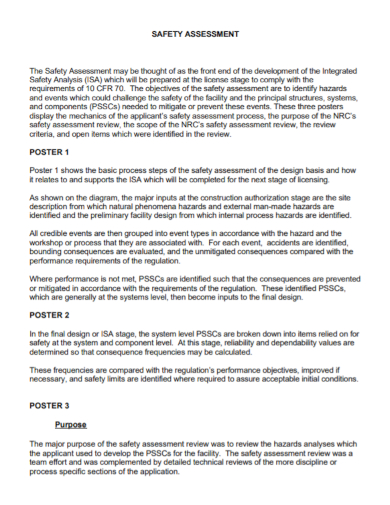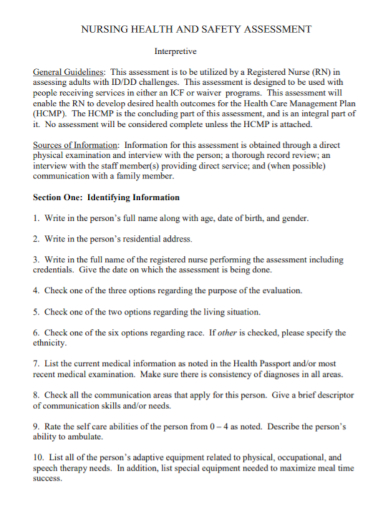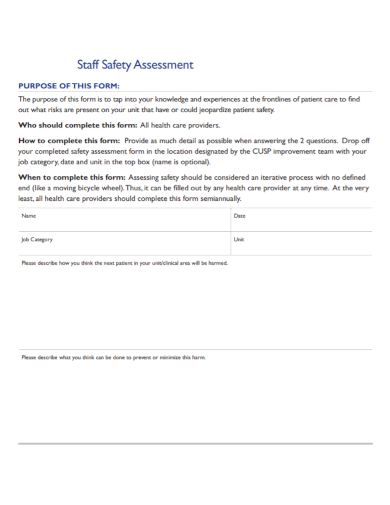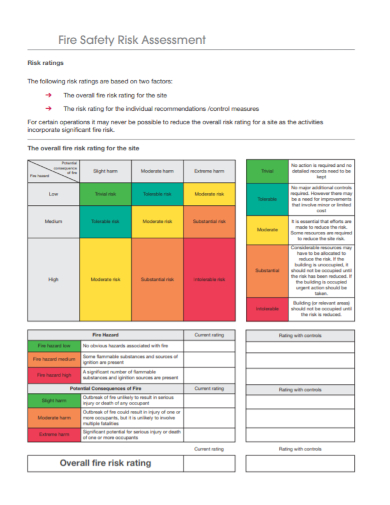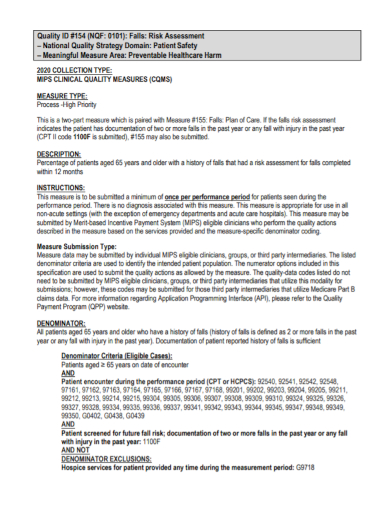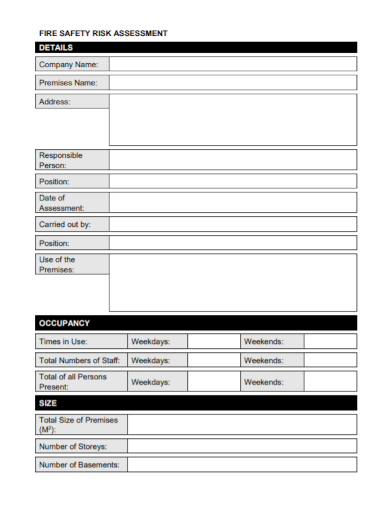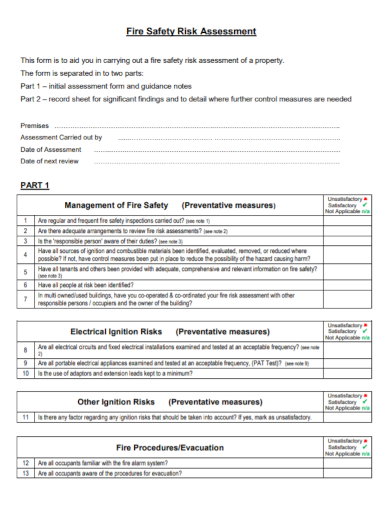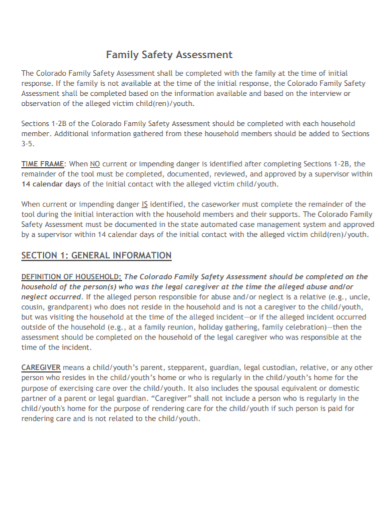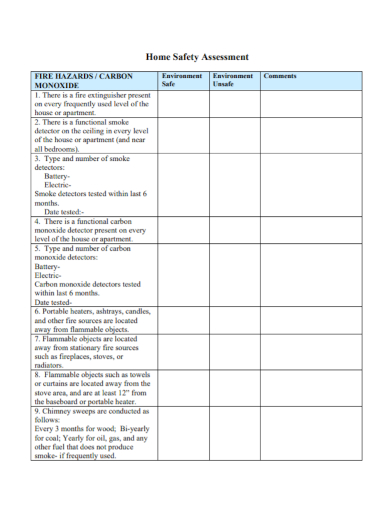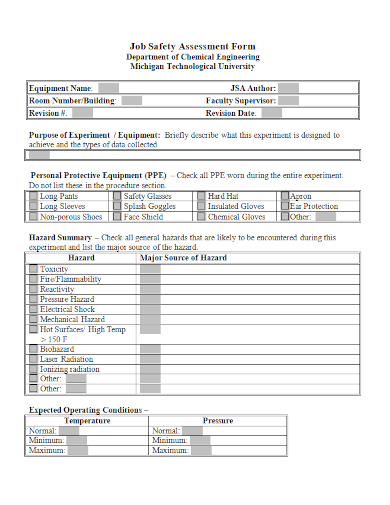Have you ever worked on a safety or risk assessment before? What did you do in order to make it an effective one? Well, for a safety assessment to become effective, you need to deliberate in creating a scope that is only intended for your assessment. Safety assessments are essential especially when it comes to providing protection to your employees. This assessment promotes awareness with regards to the potential hazards that might be existing in the workplace, identify personnel who are at risk, determine preventive measures, and prevent possible injuries and other illnesses. This is usually conducted at the beginning of a particular project, when there is a new equipment or machine, when there is a new process that needs to be implemented, introduction of raw materials, or on receipt of new information pertaining to a specific product. In this article, you will be able to know more about safety assessments.
10+ Safety Assessment Samples
1. Safety Assessment
2. Nursing Health and Safety Assessment
3. Staff Safety Assessment
4. Fire Safety Risk Assessment
5. Quantitative Safety Risk Assessment
6. Patient Safety Quality Risk Assessment
7. Company Fire Safety Risk Assessment
8. Fire Safety Risk Management Assessment
9. Family Safety Assessment
10. Home Safety Assessment
11. Job Safety Assessment Form
What is a Safety Assessment?
A safety assessment is a type of a systematic collection of various information that relates to the act of minimizing threats to family conditions, workers, and others. It encompasses specific examinations of the entire environment, process and equipment used in order to identify the hazards that may risk the health of individuals whether in short term or long term course of implementation. While there are many industries that still need to meet the standard and regulatory requirement, the main purpose of a safety assessment is to focus on giving individuals a safe and healthy environment. Improving safety helps in reducing your potential liability issues faced by your organization and to others as well.
The process needs an in-depth inspection to the overall working environment, its equipment, and its systems to determine the hazards and implement safety programs and precautions to avoid any sudden accidents or illness. Each of the working environment is unique.
When to Complete a Safety Assessment?
The safety assessment should coincide with the processes that are occurring in the working environment. It should be completed prior to the implementation of new activities, before the current activities will be changed, when hazards are already identified, when it is being required by the state legal regulations, and when it is regularly scheduled timelines for safety assessments. One of the best solution in managing hazards is to have a consistent schedule that should be applied for your safety assessment.
You may also want to consider knowing about the process of developing a criteria used to identify and define types of risks.
- Risk levels – this is about how much have you compared and measured risks in order to prioritize the most essential matters to address in the workplace.
- Probability – this answers the question “how likely it is to cause harm to the people and to the business industry?” Know the possibility and the frequency of the potential risks.
- Consequences – what would be the consequences if ever something happens? You may also look at the possible consequences in terms of business interruption, environment, legal requirements, and the reputation of the company.
- Acceptable risks – there will always be a level of remaining risks that has to be acknowledged knowing that your business is functioning in the real world setting. It is just a matter of accepting which among them is worthy to be taken into action based on the objectives of the company you are in.
- Combined risks – it is also essential to see the hazards due to the combined risks. Combined risks may result in increased consequences.
FAQs
What are the possible hazards that might be present in the workplace?
It includes physical hazards, ergonomic hazards, biological hazards, and chemical hazards.
What would a safety team do during a safety evaluation?
The safety team will examine the substitution of the risk causing materials, design of engineering controls, implementation of administrative controls, and the personal protective equipment (PPE).
What are the stages of safety assessment?
It involves identifying the hazard, collecting information and analyzing the risk, determine how to remove its effect, replacement of better equipment, and using an advanced technology.
If you want to see more samples and format, check out some safety assessment samples and templates provided in the article for your reference.
Related Posts
FREE 3+ Client Biopsychosocial Assessment Samples in PDF
FREE 10+ Joint Assessment Samples [ Strategic, Risk, Needs ]
FREE 10+ Teleworker Self-Assessment Samples in PDF | DOC
FREE 10+ Market Assessment Samples in PDF | MS Word
FREE 10+ Quality Risk Assessment Samples [ Control, Assurance, Management ]
FREE 6+ Immediate Termination of Lease Agreement Samples in MS Word | Google Docs | Apple Pages | PDF
FREE 10+ Qualitative Risk Assessment Samples in PDF | DOC
FREE 10+ Comprehensive Needs Assessment Samples in PDF
FREE 10+ Evaluation Quality Assessment Samples [ Self, Loss, Data ]
FREE 10+ Promotion Assessment Samples [ Health, Self, Employee ]
FREE 10+ Environmental Impact Assessment Samples in PDF | DOC
FREE 10+ Employee Competency Assessment Samples in PDF | DOC
FREE 10+ Change Impact Assessment Samples [ Management, Control, Request ]
FREE 10+ Qualitative Assessment Samples in PDF | DOC
FREE 10+ Staff Assessment Samples [ Workplace, Health, Risk ]

